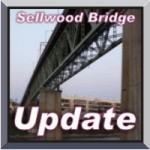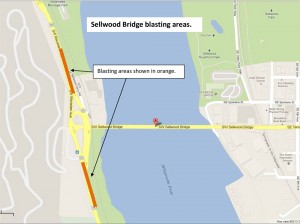 Now that the big Shoo-Fly move is history, construction on the new bridge is settling down to a normal routine. We expected this month’s Update would be pretty quiet until we heard about the next step on the West side of the river.
Now that the big Shoo-Fly move is history, construction on the new bridge is settling down to a normal routine. We expected this month’s Update would be pretty quiet until we heard about the next step on the West side of the river.
One of the major reasons the bridge needs to be replaced is the damage caused by the hillside on Highway 43. It’s basically a slow-motion landslide, and it shoved the West end of the bridge so far that the bridge buckled. If the hillside isn’t stabilized the new bridge will suffer the same fate, so stabilization is a major part of the bridge renovation. In addition, the hillside needs to be moved to make room for a new interchange between the Bridge and the Highway.
So now the contractors need to move some rock, and the best way to do that is… explosives. Blasting will take place between 8p and 3a, starting on March 13 and continuing for four weeks. Here’s all the details from the county’s Sellwood Bridge Website…
“The Sellwood Bridge Project will construct an interchange where the new bridge connects with Highway 43. A half-mile stretch of the highway near the bridge will be rebuilt to modern standards. The current highway is very narrow and constrained by a steep slope on the west side. The highway will be widened by excavating the hillside and constructing retaining walls on the west side of the current lane configuration. In 2014, traffic lanes will be shifted west while the contractor rebuilds the east half of the interchange.
with Highway 43. A half-mile stretch of the highway near the bridge will be rebuilt to modern standards. The current highway is very narrow and constrained by a steep slope on the west side. The highway will be widened by excavating the hillside and constructing retaining walls on the west side of the current lane configuration. In 2014, traffic lanes will be shifted west while the contractor rebuilds the east half of the interchange.
Underground blasting is required to break up rock during the hillside excavation. Here are some common questions the public have asked about blasting.
Why is blasting needed?
Underground blasting is needed to loosen rock that cannot easily be safely removed in its current form.
What area will be blasted?
Blasting will be used to break up rock on the west side of Highway 43 north and south of the Sellwood Bridge, beneath the orange construction zone rope line. More blasting is required north of the bridge than on the south side. The northern boundary for blasting is roughly across from the driveway to Macadam Bay.
How is blasting performed?
A subcontractor will drill holes into rock and set blasting charges. Prior to the blast at night flaggers will stop traffic in both directions on the highway and a warning siren will be sounded before the blast is detonated. After crews make sure the road is clear, flaggers will reopen the highway to traffic. In most cases, no debris will fall on the road. The loosened material will usually be excavated and trucked away the following day.
How loud will the blasting be? What will people hear?
The warning sound is required to be sounded before a blast occurs. Five minutes prior to detonation an air horn will be sounded at spaced intervals for about one minute. At one minute before detonation, the air horn will sound with shorter spaced intervals for about one minute. The last air horn will sound for about 10 seconds giving notice that the site is clear. The blast itself will last for only a few seconds. It is about as loud as a jet going overhead. The warning siren can be louder than the blast itself.
When will blasting occur?
Blasting will begin on Wednesday, March 13, 2013. Blasting will take place at night, several nights per week The exact number of blasting nights will be determined by the geology of the hillside, which is not fully known. An estimated four weeks of blasting will be needed. In a typical week, blasting will occur on three weeknights. On a typical night of blasting, two to three blasts will occur. Blasting could start as early as 8 p.m. and go as late as 3 a.m.
Why does blasting happen late at night?
Blasting is scheduled at night to minimize traffic impacts. Multiple blasts per night will help to shorten the total time needed to complete the necessary blasting and to minimize overall impacts to the surrounding community.
How will blasting impact traffic on Hwy. 43 and the Sellwood Bridge?
Flaggers will stop traffic on the bridge and on Hwy. 43 when the siren warning is sounded before a blast. For a typical blast, traffic will be held for 5 to 20 minutes. Most excavation of material happens during the day. Excavation requires flagging and lane closures (the latter during off-peak hours). Travelers can choose an alternate route to avoid delays.
How will the public be informed that blasting will occur?
The project will post alerts about blasting on the variable message signs on Hwy 43, Taylor’s Ferry and Tacoma. The project will also announce the blasting schedule on its public website and notify people who have signed up to receive the project’s Construction Updates by email. Sign up to receive alerts here.
Who is in charge of the blasting?
The sub-contractor in charge of blasting is McCallum, a firm that has worked in the Northwest for the past 20 years with highly trained, experienced and qualified staff. Blasts are designed by explosives engineers. Safe blasting practices use the latest technology to minimize disturbance to the human and natural environment.
What are the impacts of blasting?
The sound from the blast will last a few seconds and may resemble a sonic boom or a jet traveling overhead. Rock blasting may generate low-level ground vibrations and airblasts (or air pressure) that may travel from the blast site to nearby structures. Inhabitants may feel or sense resulting motions, depending on the structure, its insulation, proximity to the blast area, and the ambient inside noise level inside the structure.
How are blasting impacts monitored?
Each blast hole is loaded with carefully measured explosives topped by crushed rock reduce airblasts. Blasting seismographs will be used to measure ground vibrations and noise generated during blasting to ensure compliance with safe and regulated levels.
What regulations are in place to protect structures during blasting?
All ODOT and OSHA and US Bureau of Mines procedures will be followed. Regulations limit blasting to prevent damage to nearby properties.
The blasting program has been reviewed and approved by a number of public agencies. The blast team must comply with strict safety and security regulations that cover transportation, storage, record-keeping and handling of explosives.
How will blasting impact animals?
Some pets may be disturbed by the temporary warning signs, especially if they are outdoors. You may want to bring pets inside. Watch for their response and reassure them if necessary.
Could the blasting impact the landslide that damaged the bridge?
The project has spent the past year constructing an underground structure to hold back the landslide. Geologists say the blasting will likely not impact the landslide.
Who do I contact if I need more information or have concerns?
Mike Pullen, Multnomah County Communications Office, 503-209-4111, mike.j.pullen@multco.us. To report an after-hours noise complaint, call 503-481-1662
Multnomah County maintains the definitive website on everything related to the Sellwood Bridge Replacement project, www.sellwoodbridge.org. Construction and closure alerts, archived information, and other resources are all available 24/7 for your convenience. Their two constantly updated live webcams of the bridge cams are available here. If you’re looking for something that’s not on the website, contact Mike Pullen (mike.j.pullen@multco.us, 503-209-4111) or visit www.sellwoodbridge.org.










